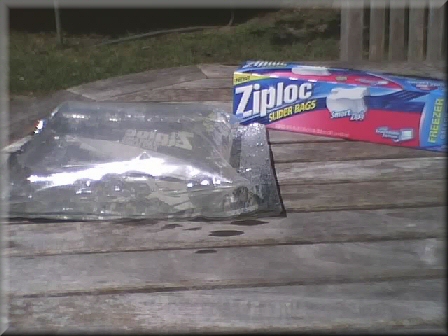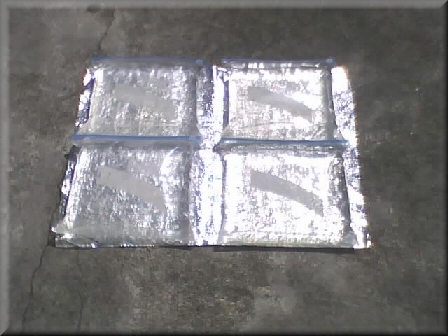
Making
Safe Drinking Water for Life!

SODIS
- Water
Bag
To learn more about SODIS in general, please refer to my previous page on this topic. I am always on the lookout for new plastic food storage and freezer bags that can be modified to serve as inexpensive and reasonably durable SODIS water bags. SODIS water bags have many advantages over bottles including they are easier to store, easier to transport, easier to distribute, and easier to fill. When off-the-shelf bags are used, the cost is low (~ 22-cents/unit). Moreover, food storage and freezer bags can be found in most markets throughout the world. However, bags leak and burst if mishandled and are challenging to store when filled. Nonetheless, in desperate situations where rapid deployment is needed - bags beat bottles every time. You can deliver 40 bags with 120-liter capacity in the space of one 2-liter bottle. I have tested several types, sizes and brands. In general, I've found the 1-gallon freezer bags with zippers to be the best. When filled with water, most of these bags will eventually leak from the zipper and the bottom seam. The trick is to find a brand with as watertight a seal as possible and then reinforce the bottom (and sometimes the sides) with clear plastic 2-inch tape. I found that folding up about 3/4-inch of the bottom seam and taping down the entire width, works well. Also, don't over fill the bags - first try about 1/2 filled (2-quarts) and don't exceed 3/4 filled (3-quarts). Finally, there may be some leakage from the zipper seal, but not enough to make a difference. There is no such thing as a completely watertight seal. Firmly press the length of the seal with your fingers to ensure it is closed. The bag needs to retain most of its' water for at least 6 hours. Particlar bags that leak too much, should be disposed. It's a good practice to test each bag before fielding. Right now, I'm using the Ziploc® Slider Bags, Smart Zip with Expandable Bottom. I will recommend this brand, until I find something better. Figures 1 and 2 show this SODIS water bag(s) in action. The zipper seals the bag (watertight) and taping the bottom so that it doesn't expand completes the picture. In general, use 1-gallon freezer bags with watertight zippers and follow the 6-steps, below: 1. Use clear plastic 2-inch adhesive tape to reinforce the bottom of the bag. Do this by folding up ~ 3/4-inch of the bottom seam and taping the entire width of the bag. Depending on the quality, you may need to reinforce the seams on both sides too. 2. Fill the bag no more than 3/4 of the way with water (< 3-quarts). First time, try just 1/2 filled (2-quarts). Press and fold the bag to remove most air. Some air will remain, but that's alright. 3. Zip the bag shut. Firmly press the length of the seal with your fingers to ensure it is closed. The little zipper tab doesn't always do the job. 4. Shake the bag back-and-forth for 20 seconds to oxygenate the water. 5. Place the bag(s) sideways on a sheet of shiny aluminum foil or aluminum canvas. The shiny aluminum reflects direct UV/IR solar energy - amplifying the waters exposure to germ-killing sunlight. Check the seal(s) one last time before walking away. 6. Allow the bag(s) at least 6 hours of direct sunlight on sunny days and 2 consecutive days when the weather is mostly cloudy. At the end of Step 6, water may be readily consumed from the bag or the water may be transfered to a more suitable storage vessel. Bags may be reused as long as they hold water. Direct storage in the bag is not recommended, but if there is no alternative, mark the date the bag(s) was made and set the bag(s) upright (zipper up). Never store any drinking water longer then six months. In conclusion, modified 1-gallon freezer bags may not represent the best SODIS water bag solution, but at less than 25-cents per unit it's an option that cannot be ignored. |
 Figure 1. Modified 1-gallon freezer bag called into SODIS service.  Figure 2. 12-quarts of hazardous water being treated by 4 handmade SODIS bags on a sheet of aluminum canvas. This amount of water will satisfy the daily needs of most households. The setup in this picture costs about $2-dollars. |